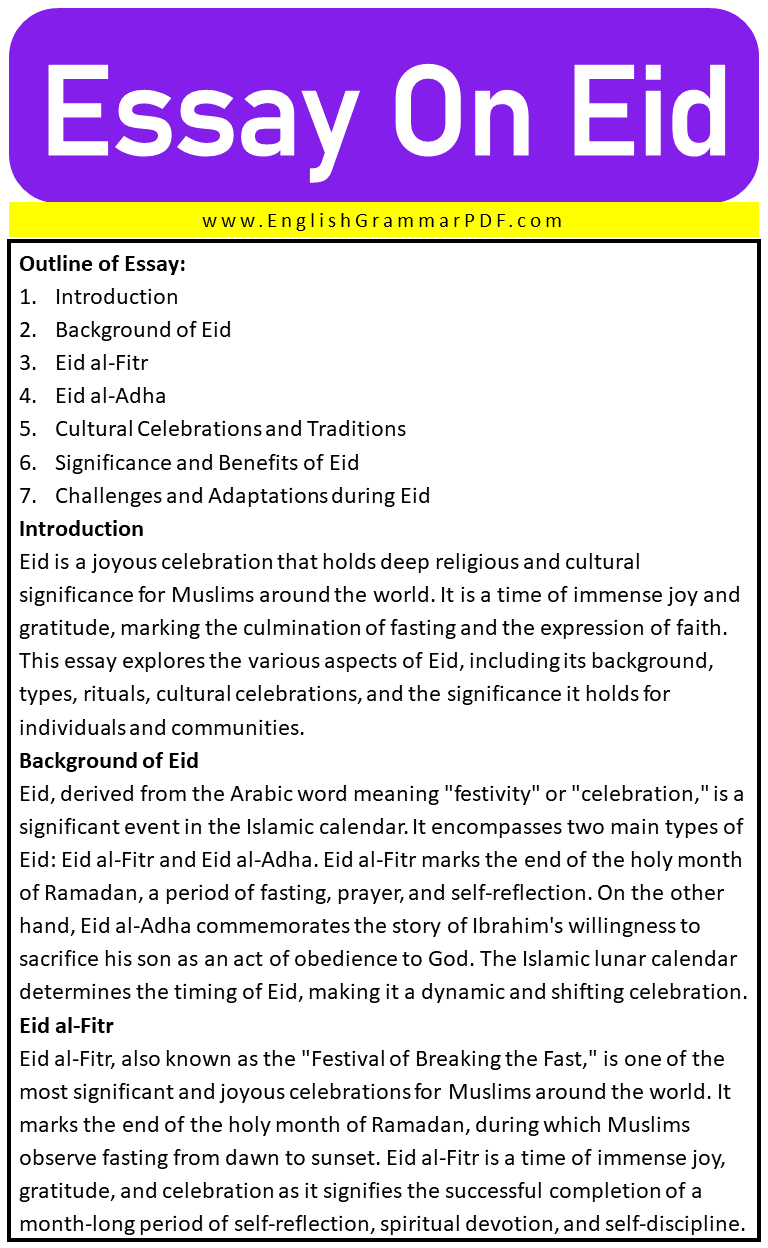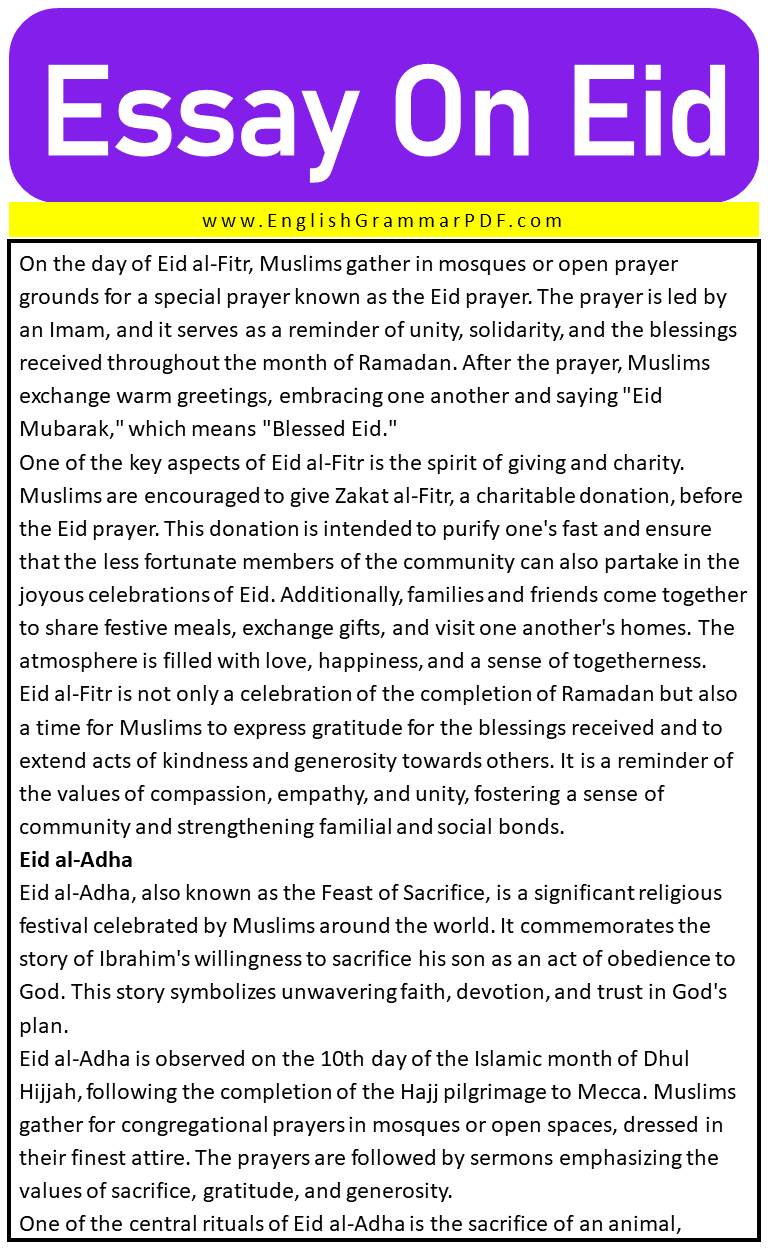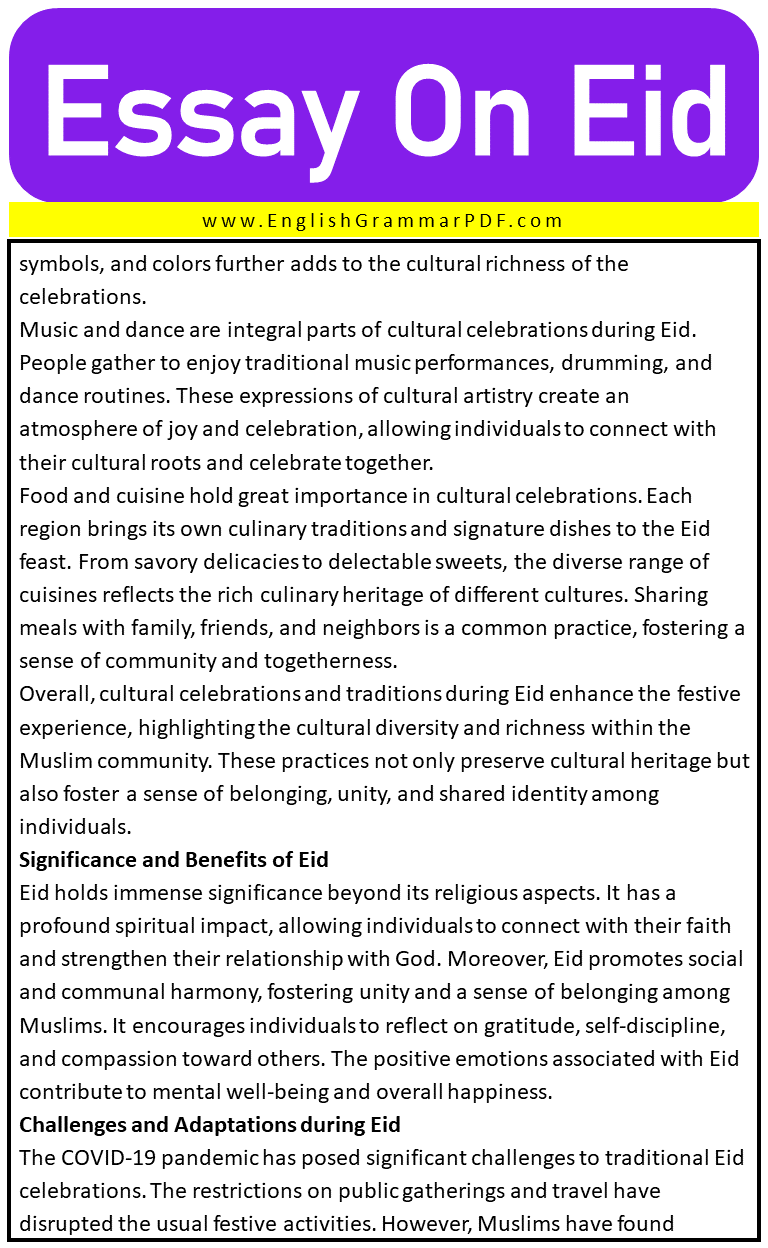Essay On Eid
Outline of Essay:
- Introduction
- Background of Eid
- Eid al-Fitr
- Eid al-Adha
- Cultural Celebrations and Traditions
- Significance and Benefits of Eid
- Challenges and Adaptations during Eid
Introduction
Eid is a joyous celebration that holds deep religious and cultural significance for Muslims around the world. It is a time of immense joy and gratitude, marking the culmination of fasting and the expression of faith. This essay explores the various aspects of Eid, including its background, types, rituals, cultural celebrations, and the significance it holds for individuals and communities.
Background of Eid
Eid, derived from the Arabic word meaning “festivity” or “celebration,” is a significant event in the Islamic calendar. It encompasses two main types of Eid: Eid al-Fitr and Eid al-Adha. Eid al-Fitr marks the end of the holy month of Ramadan, a period of fasting, prayer, and self-reflection. On the other hand, Eid al-Adha commemorates the story of Ibrahim’s willingness to sacrifice his son as an act of obedience to God. The Islamic lunar calendar determines the timing of Eid, making it a dynamic and shifting celebration.
Eid al-Fitr
Eid al-Fitr, also known as the “Festival of Breaking the Fast,” is one of the most significant and joyous celebrations for Muslims around the world. It marks the end of the holy month of Ramadan, during which Muslims observe fasting from dawn to sunset. Eid al-Fitr is a time of immense joy, gratitude, and celebration as it signifies the successful completion of a month-long period of self-reflection, spiritual devotion, and self-discipline.
On the day of Eid al-Fitr, Muslims gather in mosques or open prayer grounds for a special prayer known as the Eid prayer. The prayer is led by an Imam, and it serves as a reminder of unity, solidarity, and the blessings received throughout the month of Ramadan. After the prayer, Muslims exchange warm greetings, embracing one another and saying “Eid Mubarak,” which means “Blessed Eid.”
One of the key aspects of Eid al-Fitr is the spirit of giving and charity. Muslims are encouraged to give Zakat al-Fitr, a charitable donation, before the Eid prayer. This donation is intended to purify one’s fast and ensure that the less fortunate members of the community can also partake in the joyous celebrations of Eid. Additionally, families and friends come together to share festive meals, exchange gifts, and visit one another’s homes. The atmosphere is filled with love, happiness, and a sense of togetherness.
Eid al-Fitr is not only a celebration of the completion of Ramadan but also a time for Muslims to express gratitude for the blessings received and to extend acts of kindness and generosity towards others. It is a reminder of the values of compassion, empathy, and unity, fostering a sense of community and strengthening familial and social bonds.
Eid al-Adha
Eid al-Adha, also known as the Feast of Sacrifice, is a significant religious festival celebrated by Muslims around the world. It commemorates the story of Ibrahim’s willingness to sacrifice his son as an act of obedience to God. This story symbolizes unwavering faith, devotion, and trust in God’s plan.
Eid al-Adha is observed on the 10th day of the Islamic month of Dhul Hijjah, following the completion of the Hajj pilgrimage to Mecca. Muslims gather for congregational prayers in mosques or open spaces, dressed in their finest attire. The prayers are followed by sermons emphasizing the values of sacrifice, gratitude, and generosity.
One of the central rituals of Eid al-Adha is the sacrifice of an animal, typically a goat, sheep, cow, or camel. This act reflects the obedience of Ibrahim and his son’s submission to God’s command. The meat from the sacrificed animal is divided into three parts: one-third for the family, one-third for friends and relatives, and one-third for the less fortunate and those in need.
Eid al-Adha is a time of unity, as Muslims come together to celebrate and share the joyous occasion. Families and friends gather for festive meals, exchange gifts, and visit one another. The spirit of giving and generosity is at the heart of this celebration, as Muslims extend kindness and support to their communities.
Through the observance of Eid al-Adha, Muslims not only commemorate the story of Ibrahim but also reflect on the values of sacrifice, gratitude, and compassion. It serves as a reminder of the importance of faith, obedience, and selflessness in one’s relationship with God and fellow human beings.
Cultural Celebrations and Traditions
These celebrations provide a platform for individuals to express their cultural heritage, preserve traditions, and strengthen social bonds. Within the context of Eid, cultural celebrations and traditions add vibrancy and diversity to the overall festivities.
Eid is celebrated in various regions around the world, and each culture brings its own distinct practices and customs to the celebration. One of the most notable aspects of cultural celebrations during Eid is traditional clothing. Muslims often don their finest attire, including colorful and intricately designed garments, showcasing the cultural diversity within the community. Additionally, the application of henna, an ancient form of body art, is a popular tradition during Eid, particularly among women.
Decorations also play a significant role in cultural celebrations. Homes, streets, and mosques are adorned with colorful lights, lanterns, and banners, creating a festive ambiance. The use of traditional patterns, symbols, and colors further adds to the cultural richness of the celebrations.
Music and dance are integral parts of cultural celebrations during Eid. People gather to enjoy traditional music performances, drumming, and dance routines. These expressions of cultural artistry create an atmosphere of joy and celebration, allowing individuals to connect with their cultural roots and celebrate together.
Food and cuisine hold great importance in cultural celebrations. Each region brings its own culinary traditions and signature dishes to the Eid feast. From savory delicacies to delectable sweets, the diverse range of cuisines reflects the rich culinary heritage of different cultures. Sharing meals with family, friends, and neighbors is a common practice, fostering a sense of community and togetherness.
Overall, cultural celebrations and traditions during Eid enhance the festive experience, highlighting the cultural diversity and richness within the Muslim community. These practices not only preserve cultural heritage but also foster a sense of belonging, unity, and shared identity among individuals.
Significance and Benefits of Eid
Eid holds immense significance beyond its religious aspects. It has a profound spiritual impact, allowing individuals to connect with their faith and strengthen their relationship with God. Moreover, Eid promotes social and communal harmony, fostering unity and a sense of belonging among Muslims. It encourages individuals to reflect on gratitude, self-discipline, and compassion toward others. The positive emotions associated with Eid contribute to mental well-being and overall happiness.
Challenges and Adaptations during Eid
The COVID-19 pandemic has posed significant challenges to traditional Eid celebrations. The restrictions on public gatherings and travel have disrupted the usual festive activities. However, Muslims have found innovative ways to adapt and celebrate Eid during these challenging times. Virtual gatherings and online activities have allowed people to connect with their loved ones, share festive moments, and maintain the spirit of Eid despite the limitations imposed by the pandemic.
FAQ’s
How Eid is celebrated?
Eid is celebrated by Muslims worldwide with joy and devotion. It begins with attending special prayers at the mosque, followed by greetings and well-wishes exchanged among family and friends. Gifts are exchanged, delicious meals are prepared, and people dress in their finest clothes. Acts of charity and giving are also emphasized during Eid.
What is the special dish of Eid?
One of the most iconic and widely enjoyed dishes during Eid is Biryani. This flavorful and aromatic rice dish is made with a combination of basmati rice, meat (such as chicken, lamb, or beef), and a blend of spices. Biryani is often accompanied by various side dishes, including raita (yogurt sauce), kebabs, and sweet desserts like sheer khurma or kheer. It is a beloved dish that brings families and friends together to savor the rich flavors and celebrate the festive occasion.
Explore More Essays:
Download the PDF of the Essay:








